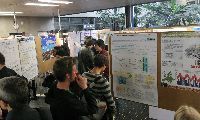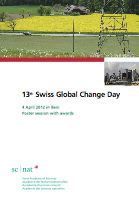13th Swiss Global Change Day - Meeting Report
On 4th April 2012 the Swiss global change research community met for the 13th time on the Swiss Global Change Day in Bern. About 270 participants attended the event and about 80 posters were presented, giving an overview of global change research activities in Switzerland.

Following the introduction by Heinz Gutscher, chair of the ProClim- steering committee, six key note speakers presented highlights and challenges in the broad field of global environmental research:
Gerhard Schmitt from the Singapore ETH Centre talked about future cities in a future climate. He gave an overview of past and present city building and pointed out the impacts of cities on the environment, in particular the heat island effect. Since by 2030 the world’s urban population will increase to 5 billion out of a world total of 8.1 billion, the city scale and city planning will be crucial. Thus, the various research modules of the Future Cities Laboratory focus on the question of how the sustainable performance of cities can be increased.
Hermann Held from the University of Hamburg examined the question of how to decide on cost-efficient investments under uncertainty. He introduced two possibilities for establishing climate targets: (1) Climate targets may be defined according to the projected impacts of global warming, and (2) Climate targets may be defined according to the precautionary principle. Held argued that neither of the two approaches works and proposed a hybrid approach of cost benefit and cost-effectiveness analysis.
Martin Grosjean from the University of Bern asked the question of whether the past might help us to constrain the future. By means of the examples of summer heat waves and floods he showed how laminated lake sediments could be used as meteorological archives. The paleo-data confirmed the multi-decadal variability of extreme events. Grosjean underlined the value of paleo-data and suggested using them more systematically for improving the understanding of the present and future climate.
Anette Reenberg from the University of Copenhagen focused on land use in developing countries. She showed the problems related to land as an increasingly scarce resource using the example of the Sahel in West Africa. Reenberg showed the complex interactions between man and the environment, i.e. climate change, globalization and population pressure, that lead to land use changes. Based on her research, Reenberg concluded that sustainable development would require transformation, which therefore should be an area of concern in global change research. (--> Presentation, 5.9 MB)
Sonia Seneviratne from the ETH Zurich examined the variable soil moisture as a thermostat for climate extremes. According to modelling and observation results, feedbacks between soil moisture and temperature are associated with important regulating mechanisms, in particular relevant for hot extremes. Seneviratne showed that the percentage of hot summer days is particularly high under two preconditions: (1) a dry winter/spring season and (2) a anticyclonic summer weather regime. (--> Presentation, 10.3 MB)
Jochem Marotzke from the Max Planck Institute for Meteorology, Hamburg, talked about the feasibility of multi-year climate predictions. Whereas surface temperature anomalies can be modelled very well for one year, the model performs poorly in predicting global mean surface temperatures for the coming decade, independent of the initialisation procedures. On the other hand, the model predicts well the surface temperatures for the North Atlantic sector, provided it is initialised, that is the initial state of the model is based on observations of slow climate components. For small-scale regions, no skill has been demonstrated yet. (--> Presentation, 1.7 MB)
In the poster session the best posters in each of the fields of WCRP, IGBP and IHDP were selected by a jury and honoured with a travel award of 1000 Swiss francs each. The following posters were awarded:
WCRP (awards were sponsored by the ACP, the Commission for Atmospheric Chemistry and Physics, SCNAT):
- Achille Mauri: The influence of atmospheric circulation on the Mid-Holocene (6000 yrs. BP) climate of Europe(--> Poster, 3.7 MB)
- Giuliana Turi: The Carbon Budget of the California Upwelling System(--> Poster, 0.7 MB)
IGBP (awards were sponsored by the Swiss IGBP Committee, SCNAT):
- Martin Hirschi: High-resolution climate change scenarios for impact studies: Pests in a future climate as an example(--> Poster, 1.2 MB)
- Christoph Schwörer: Holocene climate, fire and vegetation dynamics at the treeline in the Northwestern Swiss Alps(--> Poster, 3 MB)
IHDP (awards were sponsored by the SAGW):
- Mirjam Pfeiffer: Simulating anthropogenic fire over the Holocene using an updated fire module in the LPJ-DGVM(--> Poster, 1.5 MB)
- Martin Soland: “Relax…, greentech will solve the problem!” Optimism towards the problem solving capacity of greentech and its impact on environmental responsibility(--> Poster, 0.6 MB)
DIVERSITAS
- Sarah Burg: Observer bias and its causes in botanical records on summits(--> Poster, 0.9 MB)
Downloads/Links
- Anette Reenberg: Land use in developing countries: The triple exposure of local livelihoods
- Sonja Seneviratne - Soil moisture: A neglected thermostat for climate extremes
- Jochem Marotzke - Multi-year climate predictions: between wishful thinking and feasible decision support
- The Influence of Atmospheric Circulation on the Mid-Holocene (6000 yrs. BP) Climate of Europe - WCRP Poster 13th Swiss Global Change Day 2012
- The Carbon Budget of the California Upwelling System - WCRP Poster 13th Swiss Global Change Day 2012
- High-resolution climate change scenarios for impact studies - IGBP Poster 13th Swiss Global Change Day 2012
- Holocene climate, fire and vegetation dynamics at the treeline in the Northwestern Swiss Alps - IGBP Poster 13th Swiss Global Change Day 2012
- Simulating anthropogenic fire over the Holocene using an updated fire module in the LPJ-DGVM - IHDP Poster 13th Swiss Global Change Day 2012
- Relax..., greentech will solve the problem!" - IHDP Poster 13th Swiss Global Change Day 2012
- Observer bias and its causes in botanical records on summits - DIVERSITAS Poster 13th Swiss Global Change Day 2012

